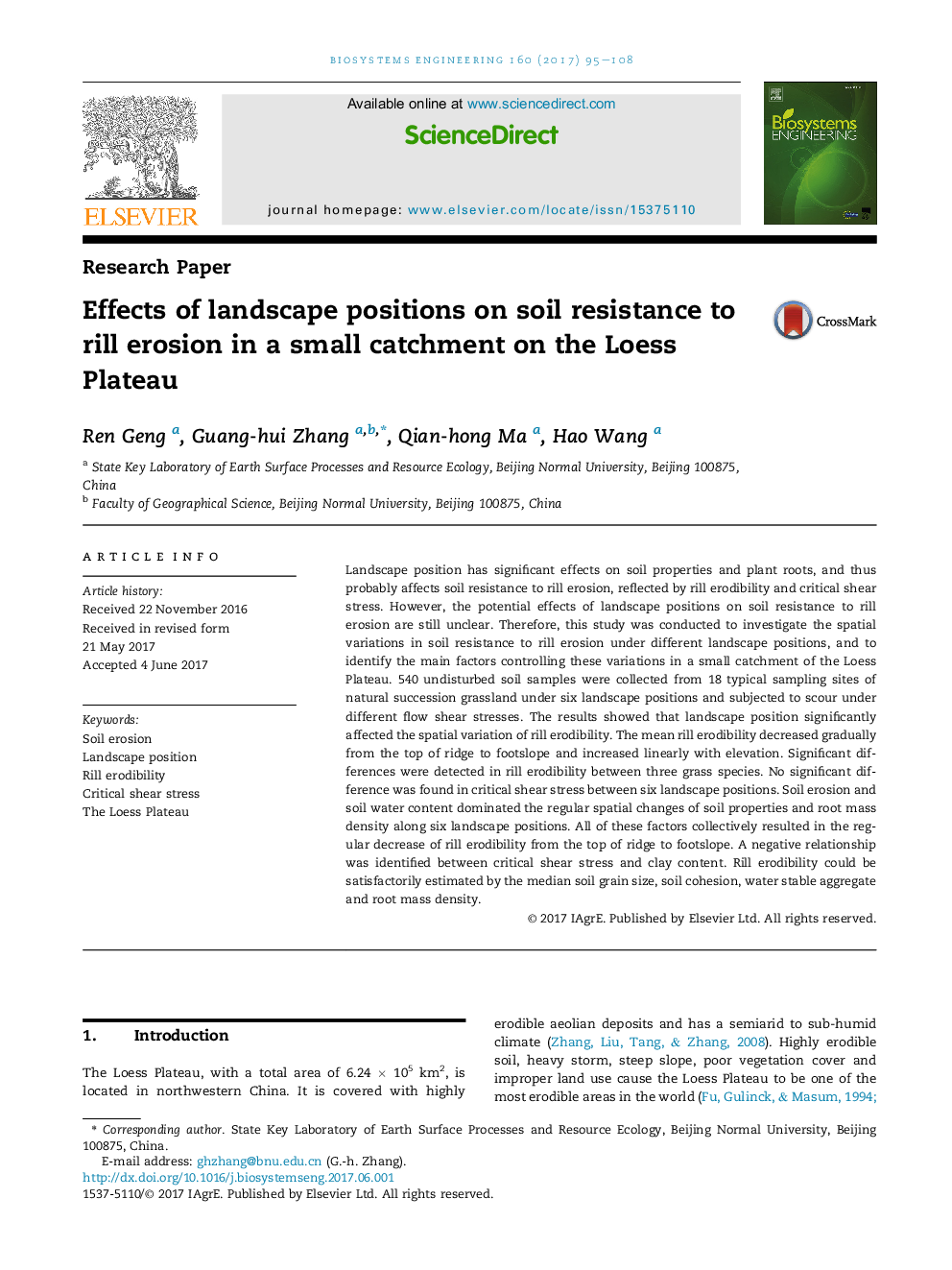| کد مقاله | کد نشریه | سال انتشار | مقاله انگلیسی | نسخه تمام متن |
|---|---|---|---|---|
| 5471817 | 1519501 | 2017 | 14 صفحه PDF | دانلود رایگان |
عنوان انگلیسی مقاله ISI
Effects of landscape positions on soil resistance to rill erosion in a small catchment on the Loess Plateau
ترجمه فارسی عنوان
اثرات موقعیت های چشم انداز بر مقاومت خاک به فرسایش لبه در یک حوضه ی کوچک بر روی افراشته لس
دانلود مقاله + سفارش ترجمه
دانلود مقاله ISI انگلیسی
رایگان برای ایرانیان
کلمات کلیدی
فرسایش خاک، موقعیت چشم انداز، فرسایش پذیری ریش، استرس برشی بحرانی، فلات لس،
ترجمه چکیده
موقعیت چشم انداز اثر معنی داری بر خواص خاک و ریشه های گیاه دارد و بنابراین احتمالا بر مقاومت خاک در برابر فرسایش لبه تاثیر می گذارد، که منعکس کننده فرسایش پذیری لبه و تنش برشی بحرانی است. با این حال، اثرات بالقوه موقعیت های چشم انداز بر مقاومت خاک به فرسایش خاکی هنوز مشخص نیست. بنابراین، این مطالعه به منظور بررسی تغییرات فضایی در مقاومت به خاک در برابر فرسایش لبه در مناطق مختلف چشم انداز و شناسایی عوامل اصلی کنترل این تغییرات در یک حوضه کوچک لابه فلائو انجام شده است. 540 نمونه خاک دست نخورده از 18 ایستگاه نمونه گیری منظم مراتع طبیعی طبیعی در شش موقعیت چشمی جمع آوری و تحت تنش های مختلف برشی تحت فشار قرار گرفتند. نتایج نشان داد که وضعیت چشم انداز به طور معنی داری بر تغییرات فضایی فرسایش پذیری ریخته شده است. متوسط فرسایش شیب دار به تدریج از بالای رد به پوزیتیوم کاهش می یابد و به صورت خطی با ارتفاع افزایش می یابد. اختلاف معنی داری در فرسایش آبشویی بین سه گونه علفی وجود دارد. تفاوت معنیداری در تنش برشی انتقادی بین شش موقعیت چشم انداز وجود ندارد. فرسایش خاک و محتوای آب خاک تغییرات فصلی منظم خواص خاک و تراکم توده ی ریشه در شش موقعیت چشم انداز را تحت تأثیر قرار داده است. همه این عوامل به طور کلی منجر به کاهش منظم فریب پذیری ریل از بالای ریف تا پوزولپس شد. رابطه منفی بین تنش برشی برشی و محتوای رس یافت شد. فرسایش پذیری ریشه می تواند با توجه به اندازه دانه های خاک متوسط، انسجام خاک، دانه های پایدار آب و تراکم ریشه ها رضایت بخش باشد.
موضوعات مرتبط
مهندسی و علوم پایه
سایر رشته های مهندسی
کنترل و سیستم های مهندسی
چکیده انگلیسی
Landscape position has significant effects on soil properties and plant roots, and thus probably affects soil resistance to rill erosion, reflected by rill erodibility and critical shear stress. However, the potential effects of landscape positions on soil resistance to rill erosion are still unclear. Therefore, this study was conducted to investigate the spatial variations in soil resistance to rill erosion under different landscape positions, and to identify the main factors controlling these variations in a small catchment of the Loess Plateau. 540 undisturbed soil samples were collected from 18 typical sampling sites of natural succession grassland under six landscape positions and subjected to scour under different flow shear stresses. The results showed that landscape position significantly affected the spatial variation of rill erodibility. The mean rill erodibility decreased gradually from the top of ridge to footslope and increased linearly with elevation. Significant differences were detected in rill erodibility between three grass species. No significant difference was found in critical shear stress between six landscape positions. Soil erosion and soil water content dominated the regular spatial changes of soil properties and root mass density along six landscape positions. All of these factors collectively resulted in the regular decrease of rill erodibility from the top of ridge to footslope. A negative relationship was identified between critical shear stress and clay content. Rill erodibility could be satisfactorily estimated by the median soil grain size, soil cohesion, water stable aggregate and root mass density.
ناشر
Database: Elsevier - ScienceDirect (ساینس دایرکت)
Journal: Biosystems Engineering - Volume 160, August 2017, Pages 95-108
Journal: Biosystems Engineering - Volume 160, August 2017, Pages 95-108
نویسندگان
Ren Geng, Guang-hui Zhang, Qian-hong Ma, Hao Wang,
